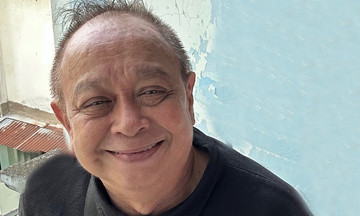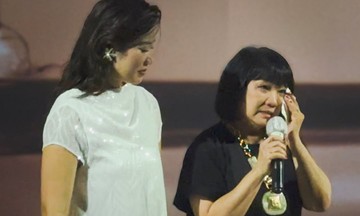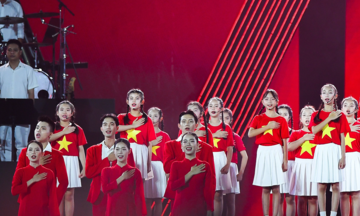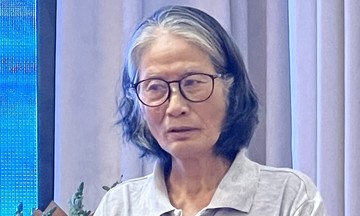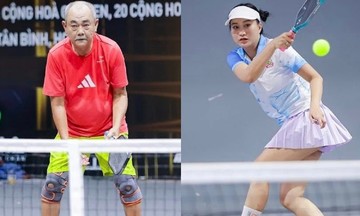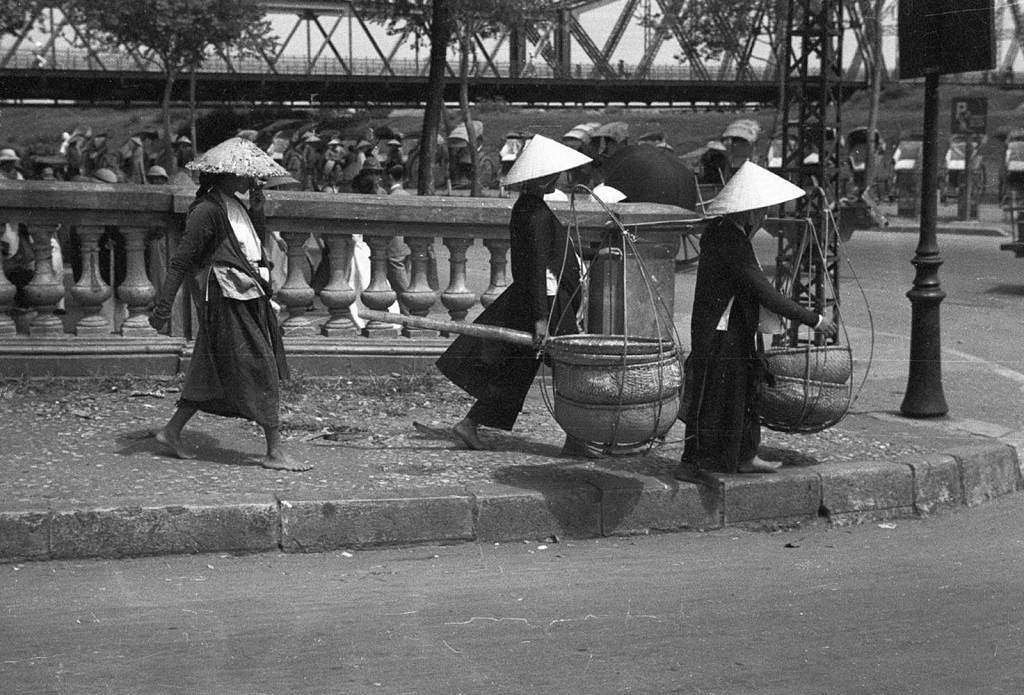 |
Women wearing four-panel dresses walk across Long Bien Bridge, Hanoi in the 1940s. Photo: American Geographical Society Library
The period from 1930 to 1975 holds immense significance in Vietnamese history, marked by revolutionary struggles under the leadership of the Communist Party of Vietnam. This era began with the Party's establishment in 1930, through the August Revolution of 1945, the establishment of the Democratic Republic of Vietnam, the resistance war against the French, the division of the country, and culminated in the victorious Spring of 1975, reunifying the nation.
During this period, many items became associated with the lives and struggles of the Vietnamese people, contributing to a vivid portrayal of their image. Among these, the four-panel dress stands out as the common everyday attire for women in the North, both in the capital and rural areas, from the 1930s to the 1950s.
Its distinctive design features two separate panels in the front and a sewn-together back. The dress was worn with a pink camisole, traditional skirt or black pants, a belt, a "crow beak" scarf, and a conical palm-leaf hat. For convenience during fieldwork, the front panels could be tied together.
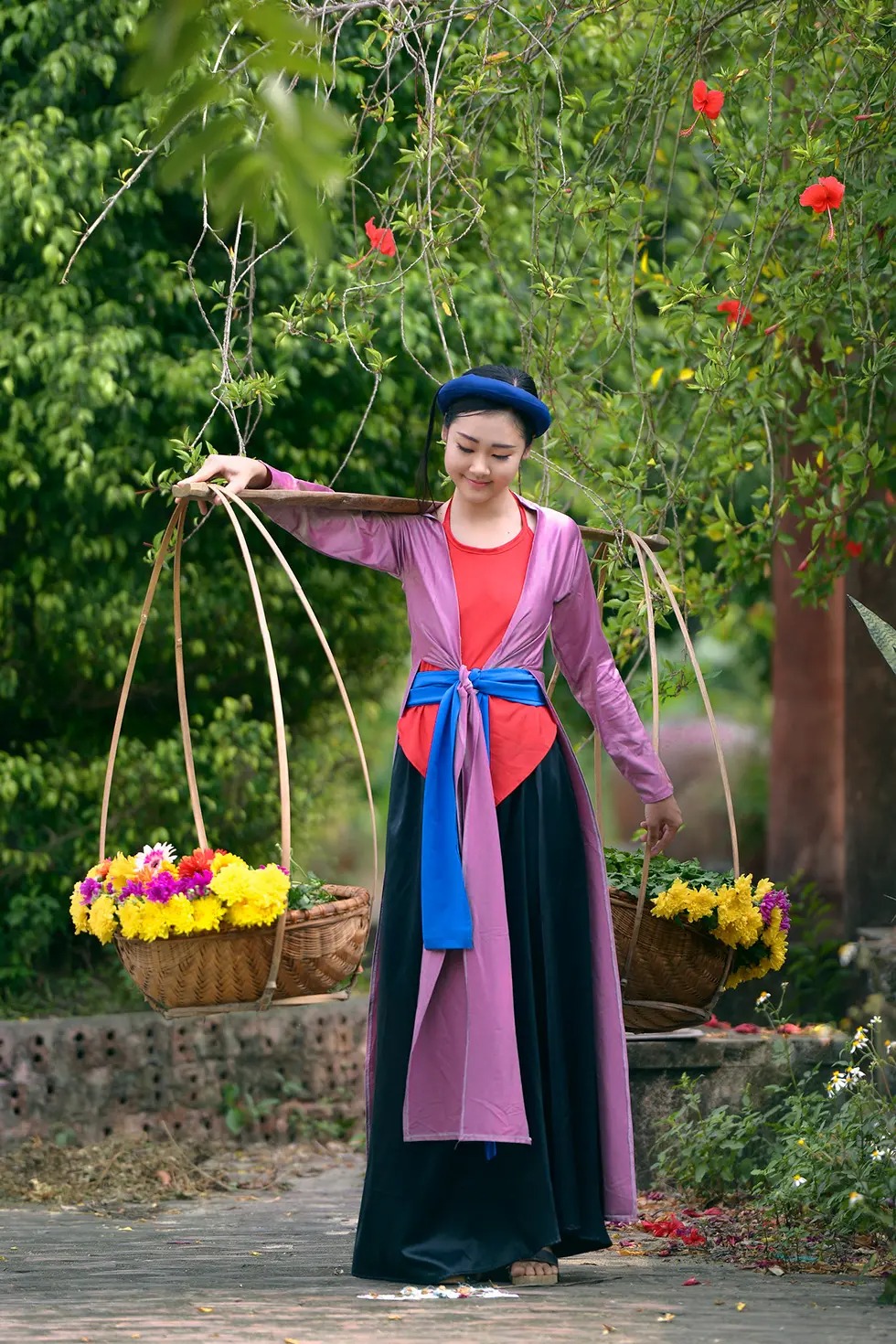 |
Gradually, with the influx of Western culture, the traditional four-panel dress was replaced by modern clothing. By the 1980s, it was primarily worn during festivals. From the 1990s onwards, it has appeared on stage, in films, and music videos. In the last 10 years, many women rent these outfits for photo shoots, at a price of around 60,000-90,000 VND per set. Photo: flickr Dinh Van Linh
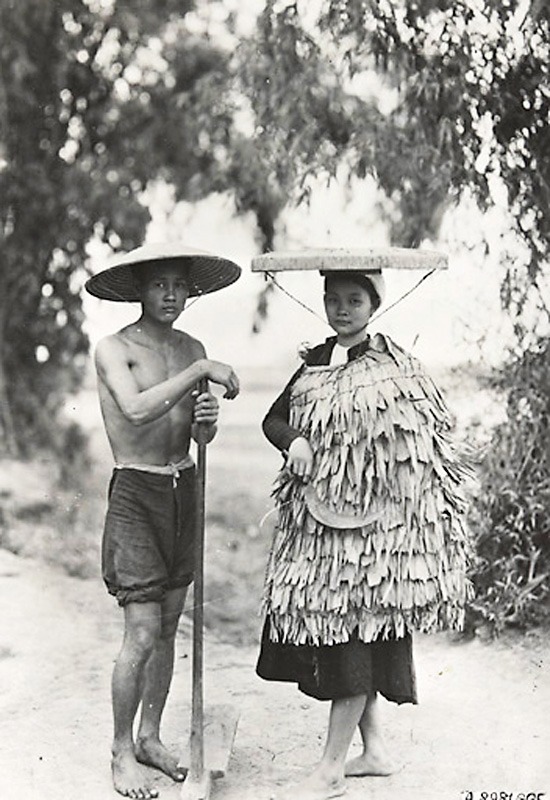 |
Accompanying the four-panel dresses was the "non quai thao" (right). The hat, with a diameter of 70-80 cm, is made of palm leaves, and has a brim of 10-12 cm. A circular frame called "khua" fits the head. The khua, made of meticulously polished bamboo strips sewn together with colorful silk threads, needs to be sturdy to support the hat's weight.
Besides the "non quai thao", people also used the conical palm-leaf hat "non la" (left), with a pointed top woven from various leaves like palm, straw, bamboo, pineapple, or coconut, and a fabric strap. This design, originating from the Tran Dynasty, is still used today by many people when going to the market, school, or working in the fields, paired with basic clothing or the "ao dai." Photo: Archive
 |
Today, the image of women wearing the "non quai thao" and the four-panel dress is mainly seen in traditional Quan Ho folk singing performances, fashion shows, music performances, films, and cultural tourism promotions.
The "non quai thao" has also become a source of inspiration for designers like Thuy Nguyen and Hoang Minh Ha, who incorporate it into their modern-traditional fashion collections. In the past two years, due to the growing trend of wearing traditional attire among young people, many hat workshops add flowers or tassels, renting or selling them for 350,000 VND and above. Photo: Kieng Can Team, TikTok Sudress
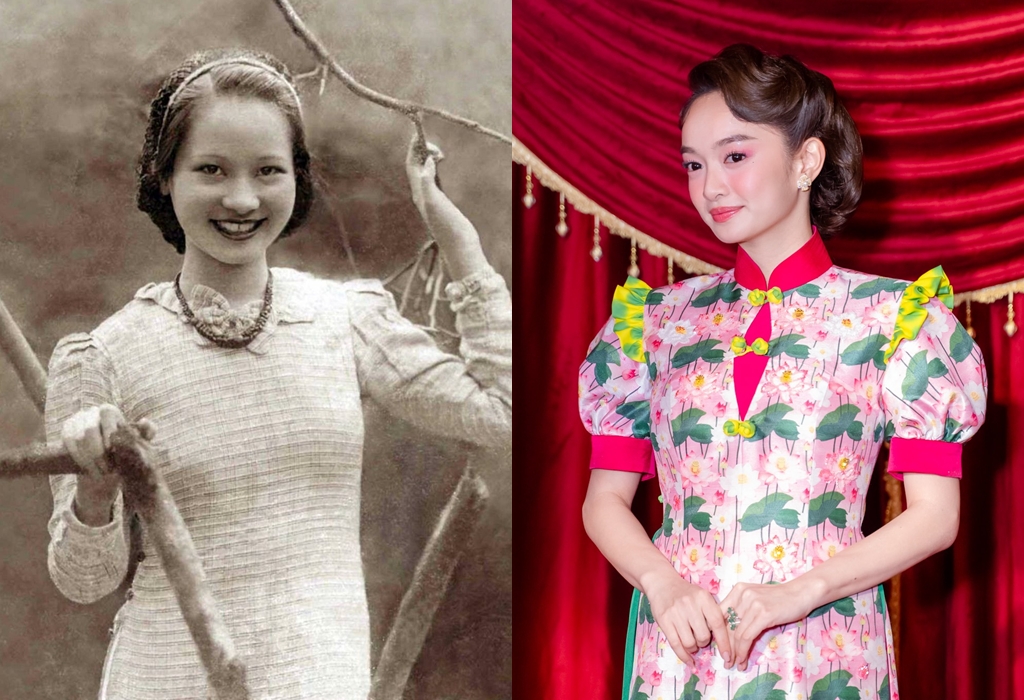 |
Amidst the four-panel dresses, five-panel dresses, and "ao dai", the Le Mur "ao dai" (left) by painter Nguyen Cat Tuong emerged as a unique phenomenon, marking a reform in women's clothing in the 1930s. Explaining the need for this reform, he wrote in the 86th issue of Phong Hoa newspaper in the spring of 1935, "Clothes, though used to cover the body, can reflect a nation's intellectual level."
From the five-panel "ao dai", he created a collarless, short-sleeved or sleeveless version with puffed shoulders, flared cuffs, no buttons, and a shorter hem. These Westernized designs were embraced by a small group of progressive women. By the early 1950s, the Le Mur "ao dai" had almost disappeared.
In 11/2024, designer Thuy Nguyen revived the Le Mur (right) in the fashion show "Ru ho xu xang xe cong." The collection featured dozens of designs with vibrant colors, bold cuts, combining a long hem with modern details like Peter Pan collars, ruffles, and cutouts. Compared to other "ao dai" styles, the Le Mur is less commonly worn in everyday life. Photo: Ao Dai Museum, Kieng Can Team
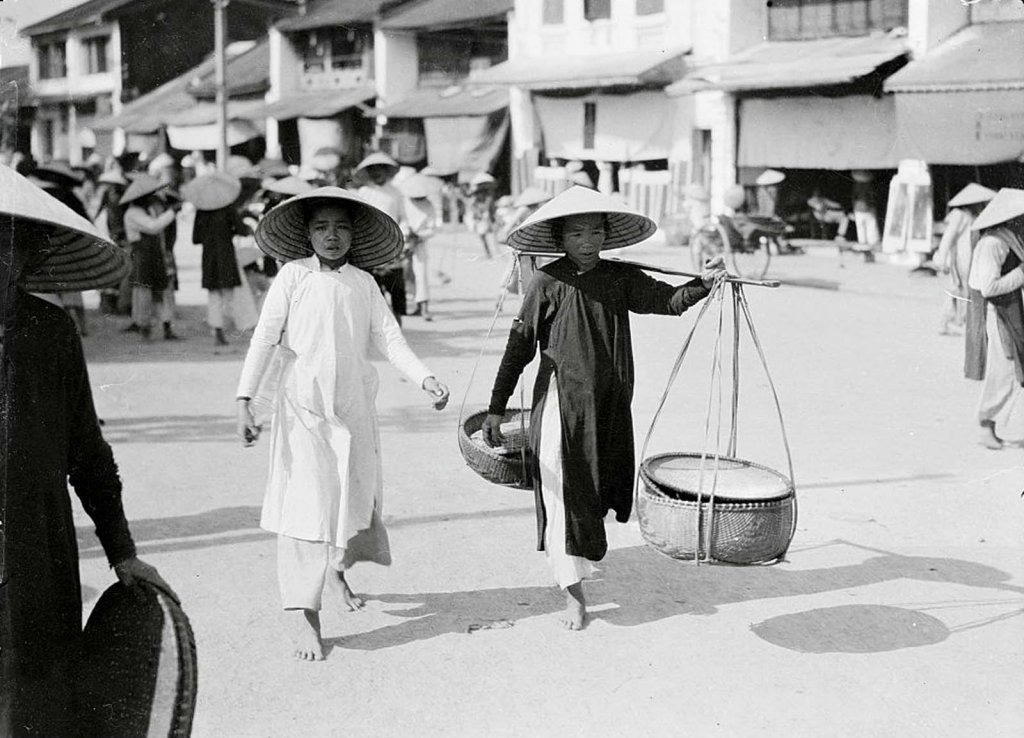 |
Besides the four-panel dress, the five-panel "ao dai" was common attire for both Northern and Southern Vietnamese before and during the resistance war against the French. It consists of five panels, a high, straight, and square collar, symbolizing integrity, and is worn with long pants. The four outer panels represent parents, and the inner panel represents the wearer. The five buttons represent the five Vietnamese virtues: benevolence, propriety, righteousness, wisdom, and fidelity.
For formal occasions, men wore the five-panel "ao dai" with metal or jade buttons, sometimes with a turban or conical hat, depending on their social status. Women's versions had lower collars, narrower sleeves, and hems often extending past the knees, worn with a camisole underneath. Colors and patterns varied according to the occasion, with red and pink for weddings, and black or brown for everyday wear. Photo: Life
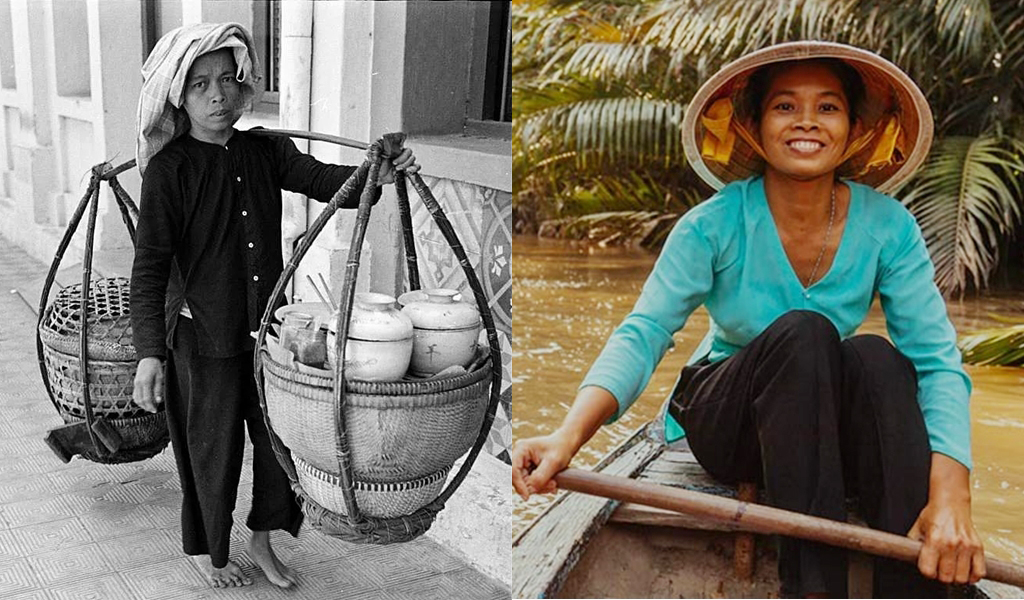 |
From the early 20th century to the 1970s and 1980s, the "ao ba ba" (tunic) was integral to the lives of people in both North and South Vietnam. Its design features no collar, a fitted waist, side slits, and is paired with a checkered scarf and conical hat. The working class often wore brown or black tunics with cropped pants.
Today, the "ao ba ba" has been modernized with a more defined waist, a heart-shaped neckline instead of the traditional round one, and raglan sleeves for a softer, more contemporary look. The colors and materials are also more diverse, including silk, chiffon, satin, brocade, and floral chiffon, replacing the traditional cotton, linen, and silk. Photo: Life, Asiatravel
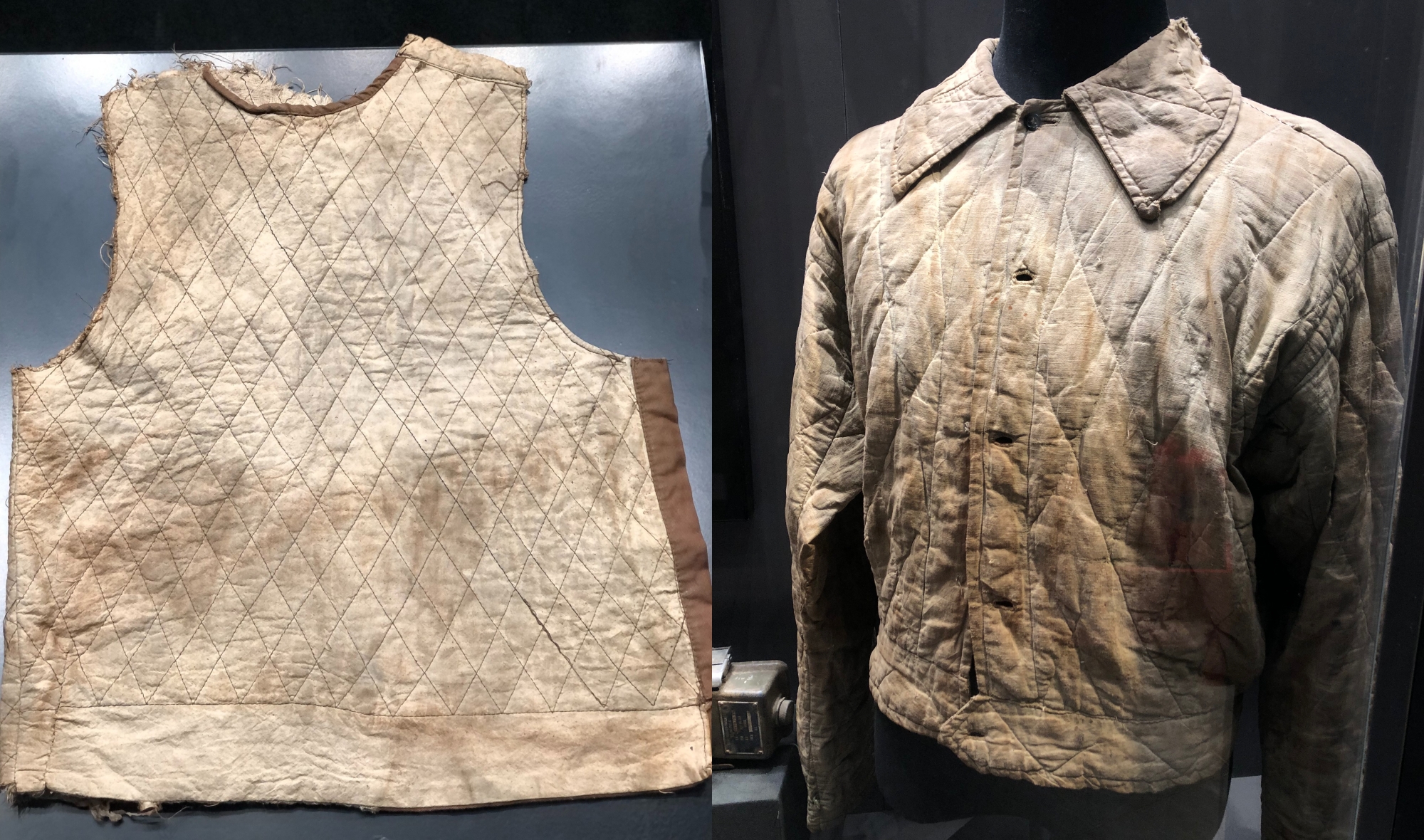 |
The quilted jacket (left) worn by hero Cu Chinh Lan of Company 12, Battalion 353, Division 304 during the battle against enemy tanks in Giang Mo, Binh Thanh commune, Hoa Binh province in 12/1951. The quilted jacket (right) worn by a soldier of Regiment 174 who died in battle at Muong Pon, Dien Bien district, Lai Chau province on 12/12/1953. Photo: Y Ly
In the winter of 1947, during the war against French colonial forces, soldiers received quilted jackets. The jacket was simple, waist-length, with a round neck, sleeveless, and made of two pieces, buttoned on one shoulder, and filled with quilted cotton. It was compact and provided good insulation. During the difficult years of the resistance war when cotton was scarce, sometimes duck feathers or dried bark were used as filling. Buttons were also in short supply, replaced by fabric ties or pressed paper buttons coated with paint.
During the Northwest Campaign in 1952, to combat the cold in the mountains, soldiers were issued long-sleeved quilted jackets. By 1953, the army began to be equipped with standardized uniforms. In the Dien Bien Phu Campaign in early 1954, soldiers wore new long-sleeved quilted jackets, carrying weapons, backpacks, and rice bags, marching in single file to the battlefield.
Today, quilted jackets are mainly used in artistic performances and films. Some cafes display them as a symbol evoking memories of the nation's heroic past.
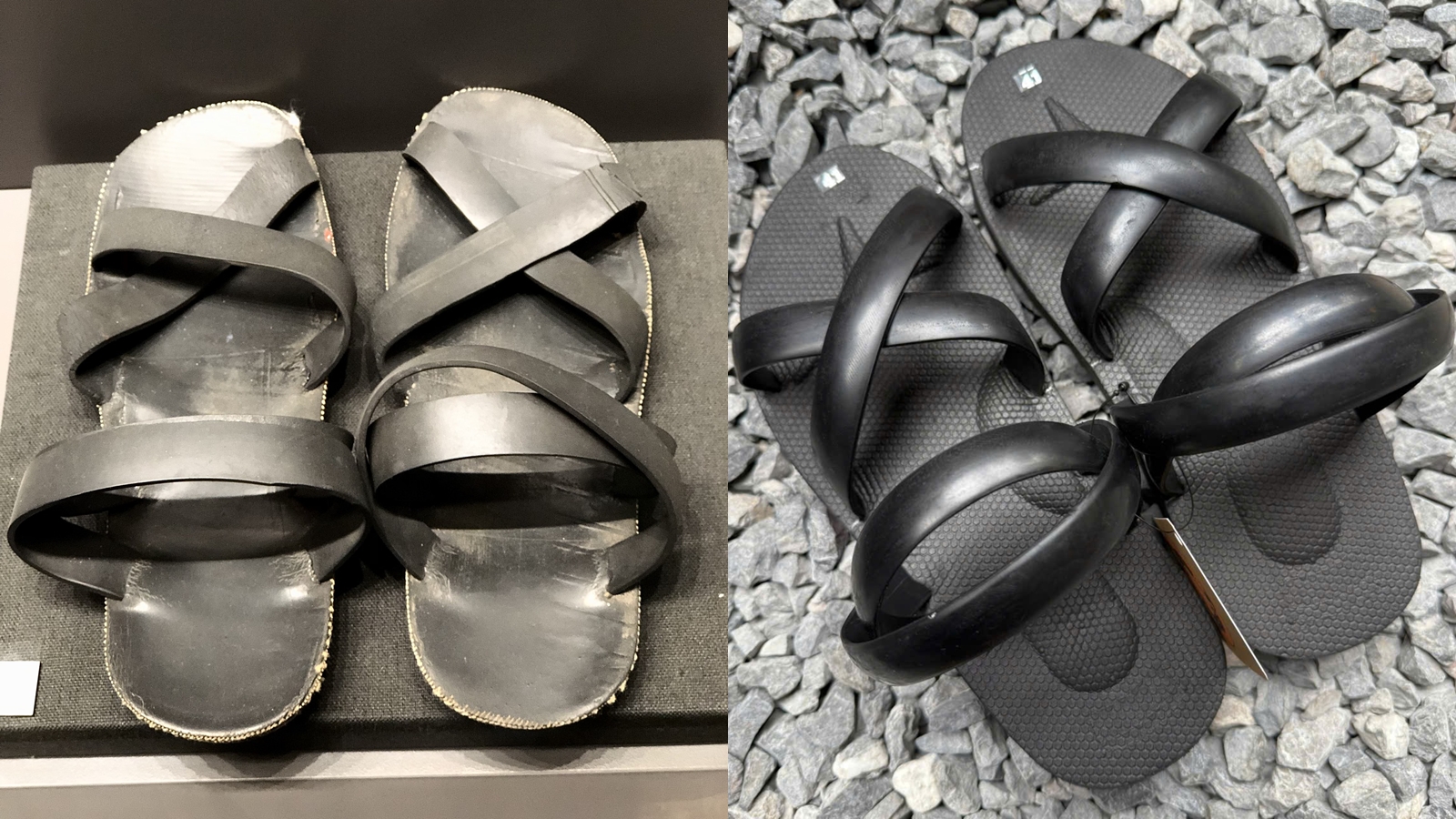 |
In 1946-1947, a soldier's belongings consisted of a pair of black tire sandals (left) and some dysentery medication. From Zone 4 northward, these sandals were known as Binh Tri Thien sandals. Rubber sandals were considered a historically valuable innovation, meeting the needs of soldiers and civilians during the resistance wars against the French and Americans.
Soldiers would cut car tires to fit their feet, punch eight holes, and thread straps made from inner tubes: two crossed straps on top, two horizontal straps at the bottom for the heel and ankle. The straps were about 1 cm wide. The straps and soles were securely fastened not with glue, but through the elasticity of the rubber. These simple, durable, and convenient sandals were easy to make, maintain, clean, and adaptable to all terrains, climates, and weather conditions in the mountainous regions during the war years.
Today, tire sandals (right) are sold as souvenirs for tourists or collectors, or seen as a fashion statement among young people. The descendants of artisan Pham Quang Xuan of the famous "Vua dep lop" brand in Hanoi continue production, expanding their business to 60 countries worldwide, with prices ranging from 250,000-450,000 VND per pair. Custom-made pairs can cost up to millions of VND.
Photo: Y Ly, Vua Dep Lop
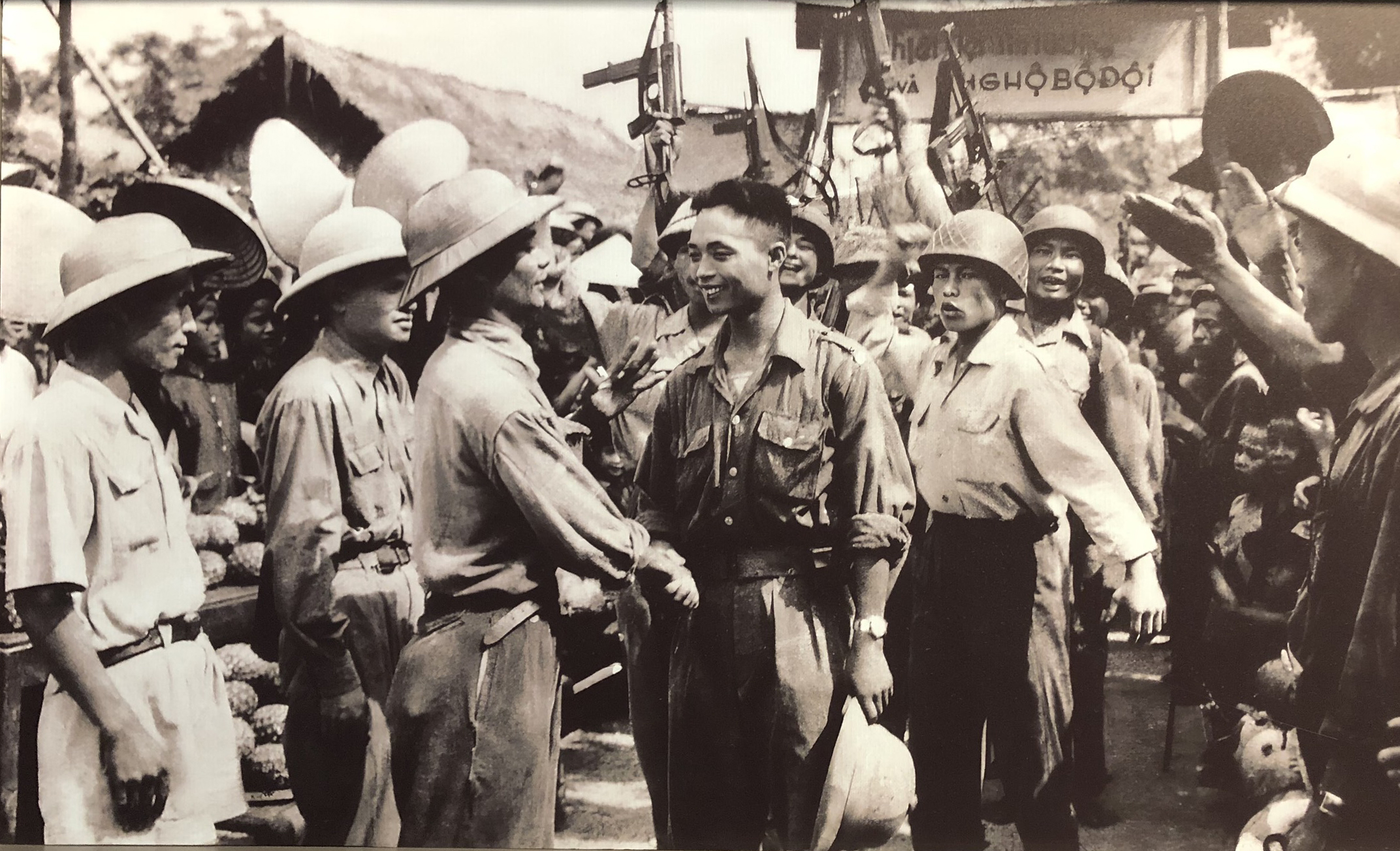 |
During the American War (1954-1975), pith helmets were a familiar item for "Uncle Ho's soldiers," youth volunteers, and militia. The helmet not only provided protection from sun, rain, and minor impacts, but could also be used to scoop water, as a seat, or a gun rest.
The pith helmet was initially called a "casque," a hard helmet introduced to Vietnam by the French in the early 20th century. In 1956, the Quartermaster Department, General Logistics Department, proposed producing a helmet similar to the casque but with a more durable material, called the pith helmet. In 1957, the pith helmet design was approved by the Ministry of National Defence and put into production.
The helmet's core is made of compressed wood pulp, bound with synthetic resin, molded, and reinforced with a rolled rim for added strength. The exterior is covered with green fabric for camouflage. The helmet also has an adjustable strap for a secure fit during combat and training. Photo: Vietnam Military History Museum
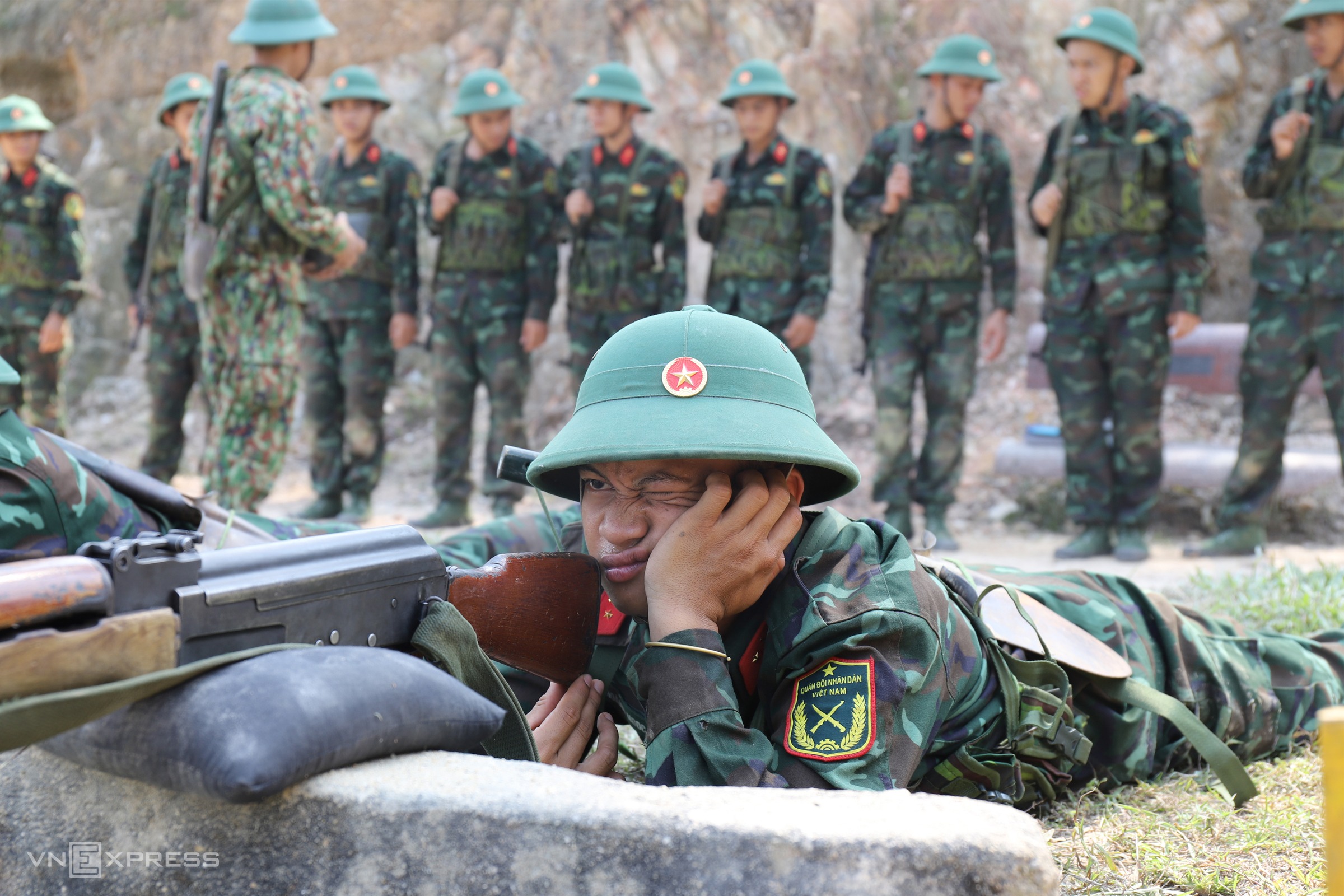 |
Today, pith helmets continue to be widely used not only in the military but also among civilians, from laborers like farmers and construction workers to those who appreciate its unique style. The helmet is favored for its durability and protection. For many, its design is a relic associated with memories of the subsidy period and the war. Nowadays, some international tourists also buy pith helmets as souvenirs when visiting Vietnam. Photo: Vo Thanh
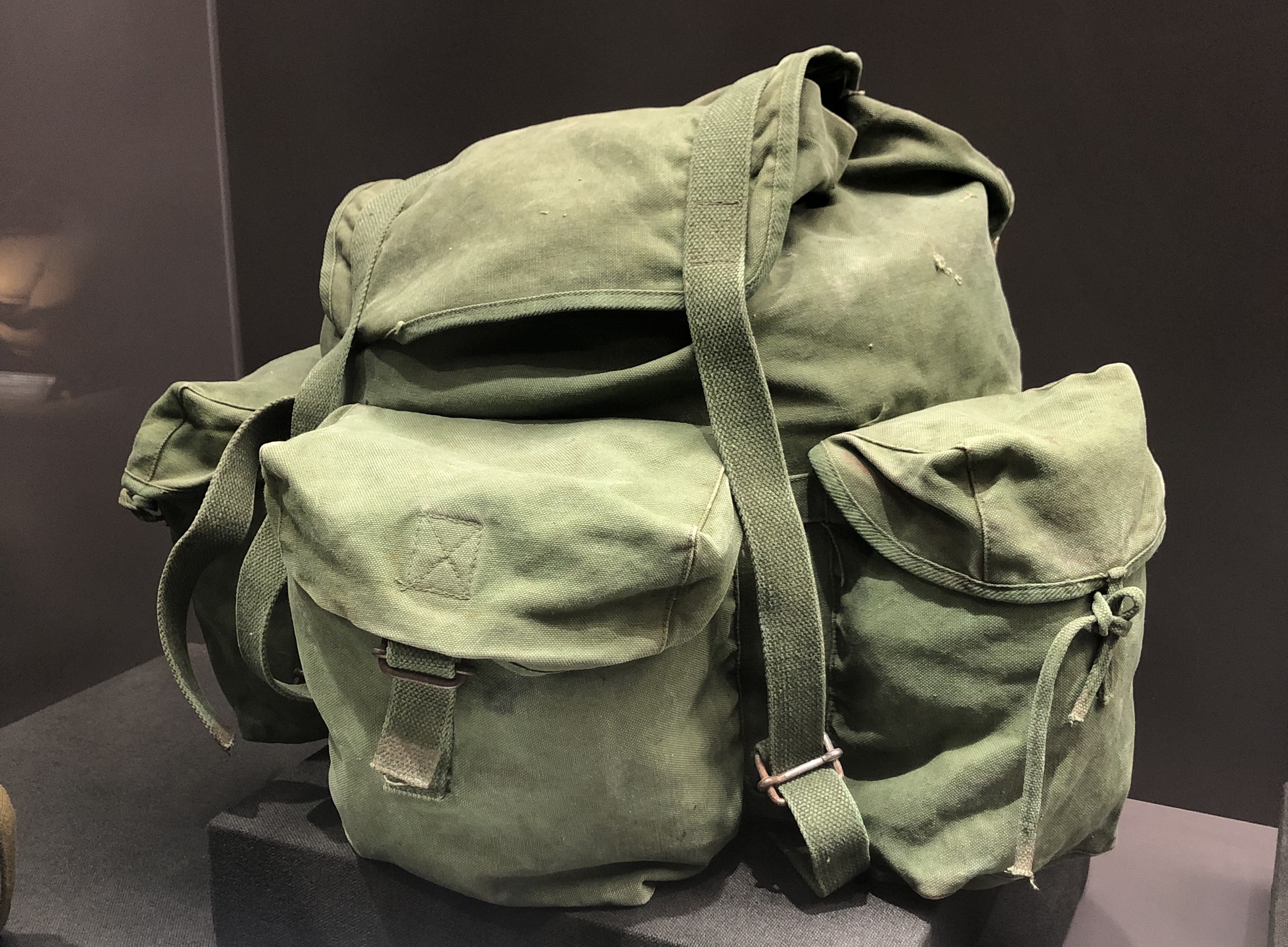 |
"You are my little uncle/ You go to the front line, you come back at midnight/ With a big toad backpack/ And a floppy hat on your shoulder." The olive-green "toad backpack" is featured in the poem "Uncle Liberation Soldier" by Cam Tho, written in a clear and familiar tone. During the American War and the Truong Son (Ho Chi Minh) Trail campaign, the toad backpack was like a close friend, holding the soldier's memories of military life. Photo: Y Ly
The backpack's name comes from its resemblance to a toad, with a bulging belly, wide bottom, and tapered top, with side pockets that puff up when filled. It was like a miniature treasure chest for soldiers, containing essential items like clothes, mosquito nets, hammocks, needles and thread, medicine, notebooks, pens, oil lamps, and balm.
Today, the toad backpack continues to be produced by the Quartermaster Department, Ministry of National Defence, with a new camouflage version for military use. Its timeless design is favored for its cool look and durability. Many people also use them for school, work, travel, or camping.
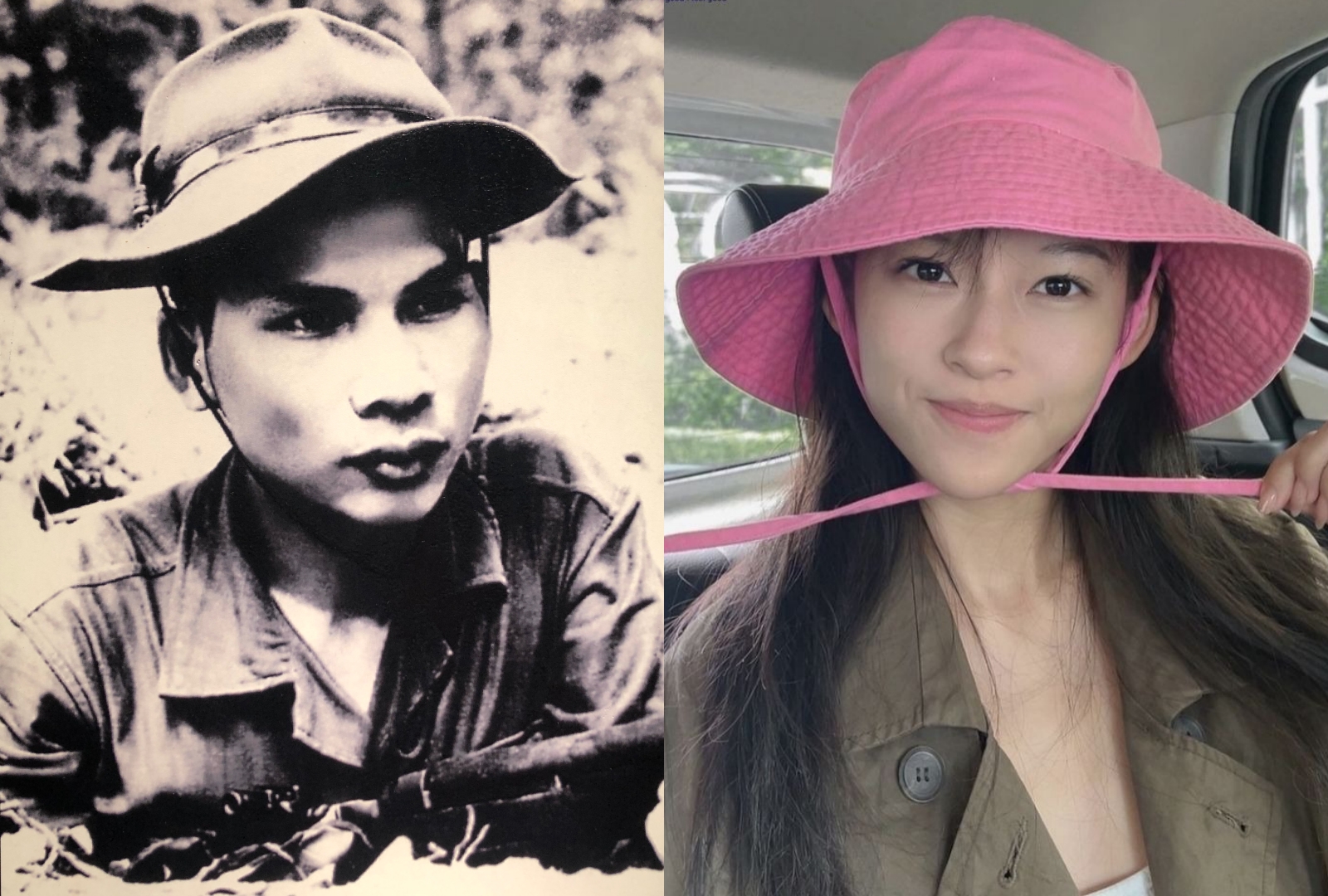 |
People's Armed Forces Hero Pham Van Coi (left) wearing a floppy hat, participating in guerrilla warfare in 1960. Born in Ho Chi Minh City, he commanded the Nhuan Duc commune guerrillas, based in Cu Chi, fighting numerous battles with rudimentary weapons and eliminating hundreds of enemies. He died in 7/1966 at the age of 26. Photo: Vietnam Military History Museum
During the American War, the image of the Southern liberation soldier was also associated with the floppy hat. It was so named because of its wide, soft brim, which rippled like water hyacinth on the river. The first hats are believed to have appeared in Ben Tre in 1960, gradually becoming widely used by soldiers. By 1966-1967, the hat officially became part of the uniform of the Southern Liberation Army.
The floppy hat remains a companion for soldiers today. To honor its design, in 2009, artisans in Quang Binh created a giant floppy hat, 2 m high and 8 m in diameter, unveiled at Phong Nha - Ke Bang. In fashion, since 2014, the floppy hat (right) has become a hot trend among young people and celebrities, including Justin Bieber, Rihanna, Miss World Vietnam Luong Thuy Linh, Miu Le, and Quynh Anh Shyn.
Y Ly




